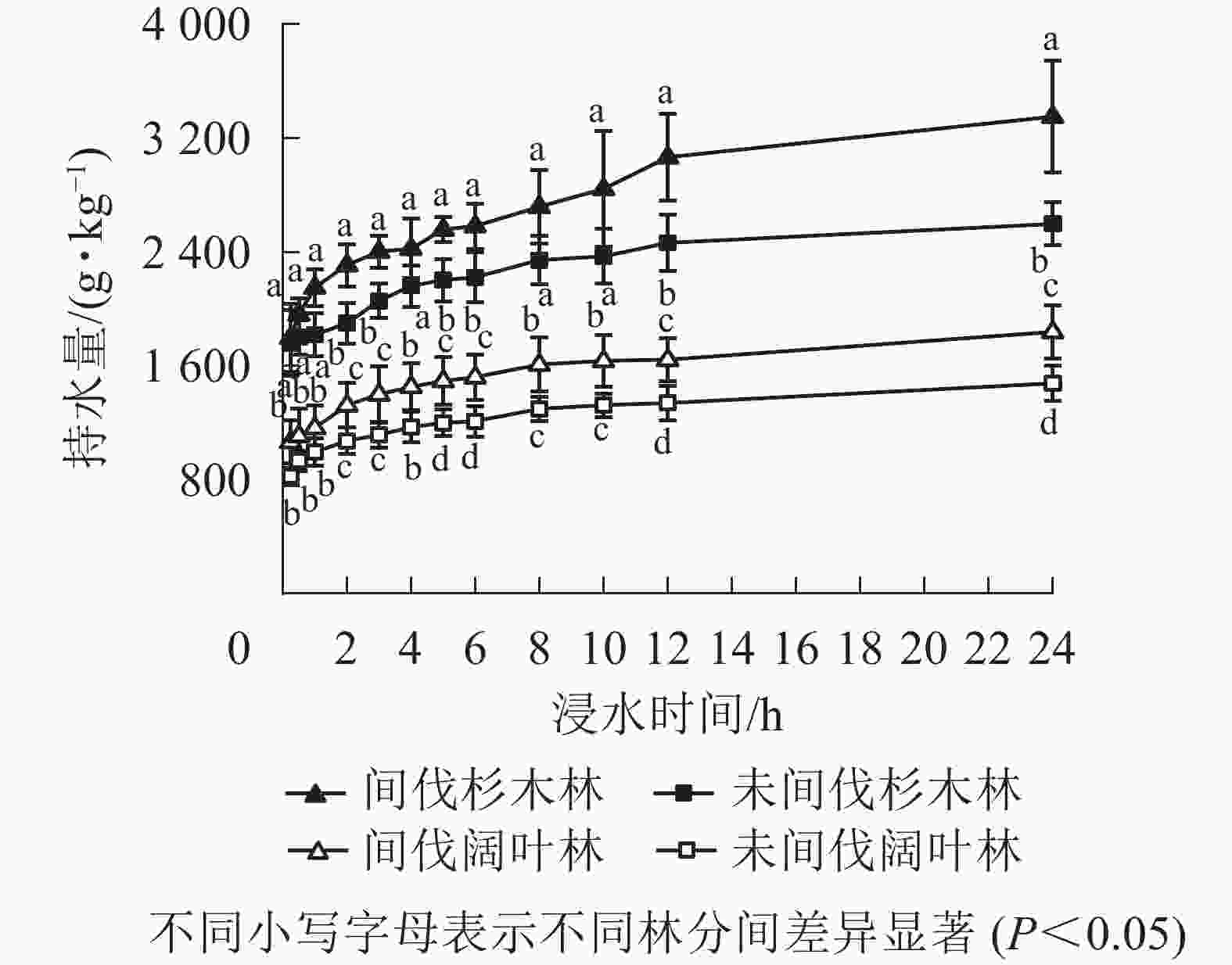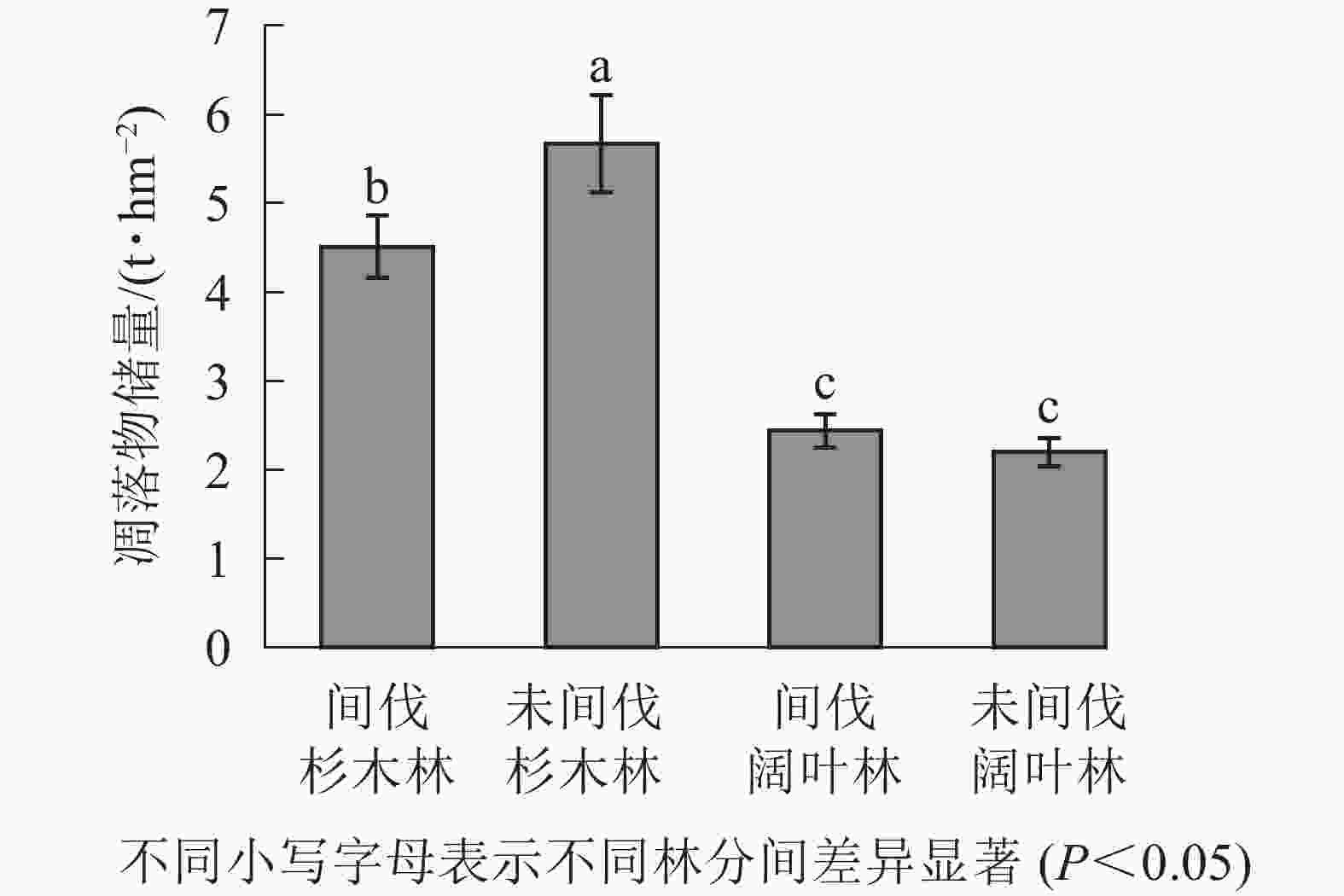-
水源涵养是森林最主要的生态功能之一,一直是生态学与水文学等相关学科研究的重点内容[1]。森林水源涵养功能表现在对降水的分配和运动作用上,其作用分为3个部分,即林冠层的截留、枯枝落叶层的吸持以及林地土壤的蓄水作用[2],其中凋落物层与土壤层的森林涵养水源能力占85%以上[3],已成为森林水文学研究的热点。近年来,众多学者开展了不同林分类型之间林下凋落物、土壤涵养水源能力的比较,以及针对单一林分类型进行抚育间伐来探讨间伐对森林水源涵养能力的影响。研究表明:林分类型对林下凋落物蓄积量、土壤孔隙度、凋落物持水量及土壤持水量存在影响[4-5]。森林抚育间伐可以调整森林生态系统结构,提高林地质量,增强林地水源涵养能力[6]。针对不同地域条件下,不同林分类型抚育间伐后在凋落物、土壤涵养水源能力方面的比较研究鲜有报道。林分类型不同,林下凋落物及土壤的涵养水源能力有所差别,但当林分密度同时发生改变时,林分之间的林下凋落物及土壤的涵养水源能力的关系是否发生变化呢?有鉴于此,本研究从野外采集凋落物与土壤,使用浸水法,全面调查和研究未间伐与间伐4 a的杉木Cunninghamia lanceolata林、阔叶林凋落物和土壤持水效能,旨在揭示间伐对杉木林和阔叶林凋落物储量、凋落物持水性能和土壤水文性质之间关系变化的影响,为揭示不同林分类型水源涵养功能提供科学依据。
-
研究区位于浙江省建德市新安江林场(29°29′N,119°16′E),属中亚热带季风气候,受新安江水库小气候影响,常年温暖湿润,降水量十分丰富。年平均气温为16.9 ℃,最热月7月平均气温为29.2 ℃,最冷月1月平均气温为4.7 ℃。年平均降水量为1 504.0 mm,年平均相对湿度为82%。年平均日照时数为1 940.0 h,年平均无霜期为254.0 d。年平均大雾日为33.0 d左右。土壤为发育于页岩的红壤土类。
研究区内主要森林类型有杉木林与阔叶林。阔叶林的主要树种有杜英Elaeocarpus decipiens、枫香Liquidambar formosana、樟树Cinnamomum camphora等。杉木林于1985年造林,初始密度为1 095株·hm−2;阔叶林于1990年造林,初始密度为2 505株·hm−2。
-
2014年10月,对浙江省建德市新安江林场范围内的杉木林、阔叶林进行较大面积间伐,以单位面积株数计,杉木林、阔叶林的间伐强度为45%~60%。为掌握间伐和林分类型对森林凋落物储量及土壤持水效能的影响,2019年9月,在3个小流域分别选取坡形、坡度、坡向等地形因子基本一致的2种林分类型(未间伐杉木林、未间伐阔叶林)和2种间伐类型(间伐杉木林、间伐阔叶林),不同处理样地面积为30~35 hm2,在不同处理林分中分别设置20 m×20 m的标准样地,调查乔木层胸径,并计算密度。不同处理林分的基本情况如表1所示。
表 1 不同处理杉木林和阔叶林样地基本情况
Table 1. Basic situation of C. lanceolata and broad-leaved forest plots in different treatments
处理 土壤类型 坡度/(°) 林龄/a 密度/(株·hm−2) 平均胸径/cm 未间伐杉木林 红壤 30 35 1 095 14.9 间伐杉木林 红壤 30 35 600 21.7 未间伐阔叶林 红壤 25 30 2 505 11.5 间伐阔叶林 红壤 25 30 1 005 15.5 -
4个处理分别设置3个重复,共计12个标准样地。在12个标准样地中,分别在样地四角及中心位置选取1 m×1 m的小样方各5个,采集凋落物装入密封袋,并在小样方位置挖掘土壤剖面,分别取0~10、10~30、30~60 cm环刀样品。
-
将采集的凋落物带回实验室,称其自然状态质量及在85 ℃烘箱中烘至恒量的质量,以干质量推算凋落物的储量,并计算自然含水率。采用室内浸泡法,称取一定量烘干的凋落物样品放入尼龙网袋(已称量)中,再将装有凋落物的尼龙网袋放入装有清水的容器中,并使其完全浸没,在浸泡0.25、0.50、1.00、2.00、3.00、4.00、5.00、6.00、8.00、10.00、12.00、24.00 h后分别取出,待沥干多余水分(无水滴滴落时)称量,每次称量所得凋落物湿质量与干质量的差值,即为凋落物样品在不同浸泡时长的持水量,并由此计算各时间段的持水速率、最大持水量、最大持水率、最大拦蓄率、有效拦蓄率、有效拦蓄量[7]。公式如下:W0=M1−M0,Rm=W0/M0×100%,W1=M2−M0,R0=W1/M0×100%,Wm=(Rm−R0)M,W=(0.85Rm−R0)M。其中:W0为凋落物最大持水量(g),Rm为最大持水率(%),M0为样品干质量(g),M1为浸泡后凋落物质量(g),M2为样品鲜质量(g),R0为自然含水率(%),W1为样品自然含水量(g),Wm为最大拦蓄量(t·hm−2),W为有效拦蓄量(t·hm−2),M为凋落物蓄积量(t·hm−2),0.85为有效拦蓄系数。
-
用环刀法测定土壤容重、非毛管孔隙度、毛管孔隙度等[8]。非毛管土壤持水量计算公式为:S=10 000Pth[9]。其中:S为非毛管土壤持水量(t·hm−2),Pt为土壤非毛管孔隙度(%),h为土壤层厚度(m)。毛管土壤持水量计算公式为:Sn=10 000Pnh。其中:Sn为土壤毛管持水量(t·hm−2),Pn为土壤毛管孔隙度(%),h为土壤层厚度(m)。土壤最大持水量是指土壤孔隙全部充满水分时的含水量。它的计算公式为:Smax=10 000Pih。其中:Smax为土壤最大持水量(t·hm−2),Pi为土壤总孔隙度(%),h为土壤层厚度(m)。
-
采用SPSS 20.0软件进行数据统计分析,单因素方差分析(ANOVA),利用Duncan法进行多重比较和差异显著性分析(P<0.05),并利用Origin 2018软件绘制图形。
-
4种处理林分的凋落物总储量为2.20~5.67 t·hm−2,从大到小依次为未间伐杉木林、间伐杉木林、间伐阔叶林、未间伐阔叶林,其中未间伐杉木林凋落物储量显著高于未间伐阔叶林(P<0.05),间伐杉木林较未间伐杉木林凋落物储量显著降低了25.2%(P<0.05),而间伐阔叶林较未间伐阔叶林的凋落物储量只是略有升高(图1)。2种林分类型间伐前后凋落物储量表现有所差异,说明间伐和林分类型对凋落物蓄积量均有不同程度的影响。
-
随着浸水时间的增加,4种处理林分的凋落物持水量呈现“快—缓慢—稳定”的增加趋势。各处理林分在开始浸水时,持水速率相差较大。整个过程中,持水量从大到小依次均为间伐阔叶林、未间伐阔叶林、间伐杉木林、未间伐杉木林。间伐显著提高了杉木林凋落物在2.00、3.00、5.00、6.00、12.00和24.00 h的持水量,间伐显著提高了阔叶林凋落物在5.00、6.00、8.00、10.00、12.00和24.00 h的持水量(P<0.05,图2)。在开始浸泡时,凋落物的持水速率都很大,这是因为凋落物处于风干状态,此时凋落物的细胞和表面水势差较大,当浸入水中后,迅速吸水,导致持水速率较大。浸水1.00 h后,4种处理林分的凋落物总持水量分别占24.00 h的63.3%~70.0%。浸泡12.00 h后,凋落物持水量基本达到饱和状态,并且各林分凋落物持水速率在浸水0.25~0.50 h时急剧下降,1.00 h后持水速率基本稳定,当浸水1.00 h时持水量增长的速度和持水速率降低的速度都变缓,可见浸水1.00 h是凋落物发挥持水能力的关键时期(图2和表2)。其中,间伐阔叶林凋落物吸水率最大,前0.25 h的持水速率高达7 190 g·kg−1·h−1,显著高于未间伐杉木林(P<0.05,表2)。

图 2 林分类型和间伐对森林凋落物持水量的影响
Figure 2. Effects of stand types and thinning on water-holding quantity of forest litter
表 2 林分类型和间伐对森林凋落物持水速率的影响
Table 2. Effects of stand types and thinning on water absorption rate of forest litters
浸水时间/h 持水速率/ (g·kg−1·h−1) 间伐杉木林 未间伐杉木林 间伐阔叶林 未间伐阔叶林 0.25 4266.6±225.6 b 3298.6±140.2 c 7190.0±483.5 a 7041.8±386.6 a 0.50 163.9±20.2 b 438.5±55.5 a 661.5±83.0 a 156.2±15.3 b 1.00 113.9±8.3 b 119.8±10.5 b 375.7±35.8 a 39.5±5.6 c 2.00 159.1±18.0 a 79.5±14.9 b 156.6±14.2 a 79.7±15.8 b 3.00 76.3±14.6 b 41.5±12.0 b 94.7±11.2 ab 158.1±17.5 a 4.00 53.4±6.3 b 55.3±8.6 b 21.3±5.1 c 104.6±10.9 a 5.00 41.1±4.7 b 29.9±10.6 b 135.0±16.8 a 41.0±9.0 b 6.00 27.3±3.5 a 11.3±1.9 b 23.1±2.6 a 19.2±3.2 a 8.00 44.0±4.9 a 43.5±12.1 a 67.9±13.2 a 60.8±11.8 a 10.00 12.8±3.8 b 13.0±1.8 b 62.7±15.8 a 13.1±4.0 b 12.00 4.0±0.6 c 7.3±1.0 c 111.0±13.4 a 47.1±6.3 b 24.00 16.3±3.4 ab 11.6±2.5 b 24.0±4.0 a 11.1±2.9 b 说明:不同小写字母表示林分间的差异显著(P<0.05) 通过拟合得知(表3),4种不同处理林分的凋落物持水量(y)与浸水时间(t)的关系,可以用多项式函数方程y=at2+bt+c进行拟合,它们之间的相关性达极显著水平(P<0.01);凋落物持水速率(y)与浸水时间(t)的关系,可以用幂函数方程y=at−b进行拟合,它们之间的相关性达显著水平(P<0.05)。
表 3 不同处理的凋落物持水量或持水速率与凋落物浸泡时间之间的回归方程与相关性
Table 3. Regression equation and correlation between water-holding capacity or water absorption rate of litter and immersion timefor different treatments
处理 凋落物持水量(y)与浸泡时间(t)的关系 凋落物持水速率(y)与浸泡时间(t)的关系 方程式 相关系数 方程式 相关系数 间伐杉木林 y=−1.607 5t2+85.37t+970.4 0.968 3** y=2 075.6 t−2.129 0.864 9* 未间伐杉木林 y=−1.252 6t2+67.24t+794.4 0.973 7** y=2 170.3 t−2.228 0.932 6* 间伐阔叶林 y=2.374 6t2+89.98t+1 799.7 0.965 5** y=3 209.1 t−1.933 0.779 8* 未间伐阔叶林 y=0.372 2t2+71.33t+1 657.3 0.980 6** y=1 635.1 t−1.877 0.704 8* 说明:* 表示0.05的显著水平,** 表示0.01的显著水平 -
间伐后的杉木林、阔叶林凋落物层有效拦蓄量、有效拦蓄率与最大持水率的变化趋势基本一致,其中间伐杉木林、间伐阔叶林凋落物层最大持水率分别较未间伐林分显著增加了24.4%和29.1% (P<0.05),间伐阔叶林凋落物最大持水量(8.2±0.5) t·hm−2,较未间伐阔叶林(5.7±0.8) t·hm−2显著增加了42.5% (P<0.05),并且间伐使阔叶林凋落物层有效拦蓄量显著增加了42.2% (P<0.05)。这些说明:间伐显著提高了林分凋落物的持水性能。间伐阔叶林最大持水率显著高于间伐杉木林(P<0.05),但两者最大持水量差异不显著(表4)。
表 4 不同林分类型凋落物的持水能力
Table 4. Waterholding capacity of litter in different stand types
处理 自然含水率/% 最大持水率/% 最大持水量/(t·hm−2) 最大拦蓄率/% 有效拦蓄量/(t·hm−2) 有效拦蓄率/% 间伐杉木林 21.4±2.2 b 183.9±29.3 c 8.0±2.4 a 162.5±40.4 c 5.9±1.7 ab 134.9±33.9 c 未间伐杉木林 33.9±0.8 a 147.8±11.3 d 8.4±1.3 a 113.9±10.5 d 5.4±0.9 ab 91.7±8.8 d 间伐阔叶林 19.8±0.7 b 335.2±20.4 a 8.2±0.5 a 315.5±38.6 a 6.4±0.5 a 265.1±32.7 a 未间伐阔叶林 15.1±4.5 c 259.7±11.3 b 5.7±0.8 b 244.6±10.9 b 4.5±0.7 b 205.6±9.4 b 说明:不同小写字母表示林分间差异显著(P<0.05) -
比较不同处理林分的土壤物理性质,结果如表5所示。随着土层深度的增加,各处理林分土壤容重呈现增大趋势,4种处理林分的3个土层的土壤容重从大到小依次均为间伐阔叶林、未间伐阔叶林、未间伐杉木林、间伐杉木林,其中在0~10、10~30 cm土层,间伐杉木林土壤容重较未间伐杉木林分别显著下降了15.5%和12.0%(P<0.05)。随着土层深度的增加,各处理林分土壤总孔隙度表现为降低的趋势,间伐杉木林的土壤总孔隙度在3个林分不同土层中始终最大,并在0~10、10~30 cm土层显著高于阔叶林的2个处理(P<0.05)。此外,间伐使杉木林10~60 cm土层非毛管孔隙度显著增加(P<0.05),却使阔叶林非毛管孔隙度仅在30~60 cm土层显著增加(P<0.05),说明间伐对土壤孔隙度的影响受林分种类的影响。
表 5 不同处理林分的土壤物理性质
Table 5. Soil property and waterholding quantity of different stand types
土层/cm 处理 土壤容重/
(g·cm−3)总孔隙度/
%毛管孔隙度/
%非毛管孔
隙度/%最大持水量/
(t·hm−2)毛管持水量/
(t·hm−2)非毛管持水量/
(t·hm−2)0~10 间伐杉木林 0.87±0.01 b 67.3±0.7 a 48.8±3.4 a 18.5±2.8 ab 672.7±6.9 a 488.1±34.0 a 184.7±28.3 ab 未间伐杉木 1.03±0.04 ab 62.9±1.4 ab 45.7±1.8 a 17.2±0.9 b 628.8±14.4 ab 457.2±17.7 a 171.7±8.7 b 间伐阔叶林 1.08±0.08 a 59.3±0.6 b 36.0±4.5 b 23.3±2.7 a 592.7±5.8 b 359.7±45.0 b 233.0±46.6 a 未间伐阔叶林 1.07±0.14 a 59.7±5.5 b 37.5±3.4 b 22.2±2.1 ab 597.0±54.5 b 374.7±34.4 b 222.3±21.1 ab 10~30 间伐杉木林 0.95±0.08 b 64.0±3.2 a 44.2±4.2 a 19.8±1.3 a 1 280.4±64.1 a 884.8±84.6 a 395.6±25.1 a 未间伐杉木 1.08±0.07 ab 60.3±2.8 ab 47.0±4.8 a 13.3±2.0 b 1 205.2±56.0 ab 939.7±95.6 a 265.5±41.0 b 间伐阔叶林 1.19±0.07 a 55.1±2.5 c 39.4±4.6 a 15.7±2.9 ab 1 102.2±50.3 c 787.6±92.16 a 314.6±57.7 ab 未间伐阔叶 1.16±0.03 a 56.4±0.9 bc 42.4±3.1 a 14.2±2.6 b 1 128.3±18.1 bc 847.0±62.2 a 281.3±51.8 b 30~60 间伐杉木林 1.04±0.03 b 60.7±0.9 a 42.0±1.1 a 19.3±0.8 a 1 822.1±27.1 a 1 244.7±33.8 a 577.5±22.9 a 未间伐杉木林 1.10±0.11 ab 59.6±4.4 ab 44.3±3.6 a 15.3±4.3 b 1 787.4±132.1 ab 1 328.2±107.1 a 459.2±125.3 b 间伐阔叶林 1.26±0.01 a 52.4±0.4 c 31.8±3.2 b 20.6±3.3 a 1 573.1±12.1 c 954.6±95.2 b 618.5±97.4 a 未间伐阔叶林 1.22±0.14 a 53.9±5.2 bc 40.0±4.5 a 13.9±3.6 b 1617.0±156.7 bc 1 198.8±134.4 a 418.2±108.8 b 说明:不同小写字母表示林分间的差异显著(P<0.05) -
不同处理林分土壤的水分保蓄能力存在差异。同一土层的土壤最大持水量从大到小依次为间伐杉木林、未间伐杉木林、未间伐阔叶林、间伐阔叶林,间伐杉木林土壤(10~30 cm)的最大持水量显著高于阔叶林的2个处理(P<0.05),说明间伐杉木林土壤持水性能最好。同时,间伐使杉木林非毛管持水量在10~30、30~60 cm土层分别显著增加了49.0%和25.8%(P<0.05),使阔叶林非毛管持水量在30~60 cm土层显著增加了47.9%(P<0.05),而2个间伐处理的土壤非毛管持水量无显著性差异(表5)。土壤储水特性主要体现在土壤持水量大小。将不同处理林分各土层最大持水量相加,得到0~60 cm最大持水量为3 268.0~3 775.2 t·hm−2,杉木林与阔叶林这2种林分类型间存在显著性差异(P<0.05),并且不受间伐措施的影响。土壤非毛管持水量反映了土壤有效持水量,因此,将不同处理林分各土层非毛管持水量相加,得到0~60 cm土壤非毛管持水量(896.4~1 166.1 t·hm−2)。由图3可知:各处理林分非毛管持水总量存在差异,间伐杉木林较未间伐杉木林显著增加了29.2%(P<0.05),间伐阔叶林较未间伐阔叶林增加了26.5%(P<0.05),说明间伐能够改善土壤孔隙度,增加土壤有效持水量。
-
森林凋落物储量受凋落物的输入量、分解速度、累积年限、树种组成和林分密度、生态恢复措施等的综合影响[10-12]。在一定林分密度范围内,随着林分密度的增加或减小,林内凋落物储量随之增加或减小[13-14]。本研究中,间伐杉木林凋落物储量显著低于未间伐杉木林,这主要是由于间伐杉木林密度小于未间伐杉木林,通过间伐,林分密度的减少一方面减少了森林生物量,另一方面会使林分郁闭度降低,林内透光性增强,更利于凋落物的分解,使得凋落物积累量较未间伐杉木林显著减少。这与间伐华北落叶松Larix principis-rupprechtii凋落物储量低于未间伐华北落叶松的结果相似[15]。本研究中,间伐阔叶林凋落物储量高于未间伐阔叶林,但两者之间的差距较小,这主要是由于未间伐阔叶林林分密度过大,植株间竞争过大,导致植株生长受到影响,森林生物量较少;另一方面间伐的阔叶林生物量增加,同时林内增加的光照与地表温度加速凋落物的分解,最终两者之间凋落物储量差距不明显。这与间伐强度为50%的大兴安岭用材林的研究结果相似[16]。本研究中杉木林凋落物储量大于阔叶林,这与楠杆自然保护区不同植被类型凋落物储量的研究结果一致[17]。
不同处理林分凋落物持水性能和持水速率的变化具有相似的规律,这与浙江省主要森林类型的研究结果一致[4,11]。凋落物持水量与浸泡时间存在多项式函数关系,而凋落物持水速率与浸水时间的关系为幂函数。凋落物持水能力受树种组成、发育阶段、垂直结构及凋落物分解程度等因素的影响[18]。林分间伐后,凋落物的储量不同,持水能力也会有较大差异。本研究中,间伐林分凋落物最大持水率、有效拦蓄量、有效拦蓄率均大于相对应未间伐林分,其中最大持水率、有效拦蓄率有显著增加,这与小五台山华北落叶松林最大持水率在不同间伐强度间差异不显著的研究结果不一致[19],其原因可能是由于树种不同,凋落物的枝叶比例有差异。间伐杉木林凋落物最大持水量、有效拦蓄量与未间伐杉木林之间的差异不显著,这主要是因为凋落物最大持水量、有效拦蓄量与凋落物储量有密切关系。而间伐阔叶林凋落物最大持水量、有效拦蓄量较未间伐阔叶林显著增加,这是由于间伐增加了凋落物的持水效能。这与抚育间伐天然次生林显著增加了未改造林地凋落物最大持水量、有效拦蓄量的研究结果相似[20]。间伐阔叶林凋落物的最大持水量、有效拦蓄量稍大于间伐杉木林,未表现出显著性差异,这是由于不同树种间伐后凋落物储量、持水效能等变化情况不一致导致的。
土壤孔隙度直接影响土壤的通气性及渗透性能,土壤容重随着孔隙度的变大而减小,孔隙度越大土壤有机质含量越多,土壤结构越疏松,越有利于雨水下渗,减少地表径流[21]。间伐提高了杉木林各个土层土壤非毛管孔隙度和土壤总孔隙度,降低了各土层土壤的容重,改善了土壤水文物理性质,增强了各土层土壤蓄水能力。杉木林抚育间伐后,土壤的水文物理性质得到明显改善,这与抚育间伐不同龄林杉木人工林的研究结果一致[22]。间伐也提高了阔叶林各个土层非毛管孔隙度,但土壤容重却升高了,这与间伐强度为5%的秦岭林区锐齿槲栎Quercus aliena var. acuteserrate林的研究结果相似[23]。这可能是间伐过程中人为作业、踩踏等加大了土壤容重,而间伐后树木根系的死亡,增加了土壤非毛管孔隙度。土壤非毛管孔隙度是决定土壤储水量的重要因素,是影响森林土壤水源涵养及水土保持功能的主要因素[24]。抚育间伐后,杉木林和阔叶林不同深度土壤非毛管持水量增加,不同深度土壤间伐杉木林最大持水量均显著大于间伐阔叶林。土壤非毛管持水量随着林分的间伐而增大,最大持水量因林分不同间伐后表现出不同变化趋势。抚育间伐降低了林分密度,林内的凋落物更易分解,土壤的水文物理性质得以改善,土壤蓄水能力随之增强。
综上所述,间伐显著提高了杉木林和阔叶林凋落物的持水能力和土壤的持水性能,同时间伐改变了杉木林与阔叶林之间凋落物储量、凋落物持水性能的关系,4个处理中以间伐杉木林的凋落物和土壤整体水源涵养功能最强。
Effects of thinning and stand types on litter stock and soil water-holding capacity
-
摘要:
目的 探讨间伐和林分类型对森林凋落物储量及土壤持水效能的影响,为提高不同林分类型水源涵养功能提供科学依据。 方法 以浙江省建德市3个小流域的间伐与未间伐杉木Cunninghamia lanceolata林和阔叶林为对象,野外采集凋落物与土壤(0~10、10~30、30~60 cm)样品,测定凋落物的储量、持水率和持水量以及土壤的容重、孔隙度和持水量。 结果 杉木林间伐较未间伐的凋落物储量降低了25.2%(P<0.05),而凋落物最大持水率和有效拦蓄率分别增加了24.4%和47.1%(P<0.05);间伐对阔叶林凋落物储量无显著影响,但凋落物最大持水量和有效拦蓄量分别比未间伐的增加了42.5%和42.2%(P<0.05);凋落物持水性能总体表现为间伐林分高于未间伐林分。间伐显著提高了杉木林10~60 cm土壤非毛管孔隙度和非毛管持水量(P<0.05);间伐显著增加了阔叶林30~60 cm土层土壤非毛管孔隙度(P<0.05)及0~10、30~60 cm土层土壤非毛管持水量(P<0.05);间伐杉木林各土层土壤最大持水量均显著高于间伐阔叶林(P<0.05),并且间伐杉木林0~60 cm土层土壤最大持水量(3 775.19 t·hm−2)高于其他林分。 结论 间伐显著提高了森林凋落物的持水能力和土壤的持水性能,其中间伐杉木林凋落物及土壤整体的水源涵养功能最强。图3表5参考24 Abstract:Objective This study aims to explore the effects of thinning and stand types on forest litter stock and soil water-holding capacity, and to provide scientific basis for evaluating water conservation function of different forest stands. Method Two forest types (Cunninghamia lanceolata forest and broad-leaved forest) and two types of thinning (thinning C. lanceolata forest and thinning broad-leaved forest) in three small river basins in Jiande City, Zhejiang Province were taken as the research objects. Litter and soil (0−10, 10−30, 30−60 cm) were collected in the field, and the water immersion method was used to analyze the influence of thinning on the forest litter stock and water-holding capacity of different forest stands. Three standard plots (20 m×20 m) were selected in each forest stand for litter collection and soil sampling. The litter stock, water-holding capacity and water absorption rate, as well as the soil bulk density, porosity and water-holding capacity were determined. The statistic data of litter and soil characteristics were analyzed using one-way ANOVA and Duncan. Result The litter stock of thinning C. lanceolata forest decreased by 25.2% (P<0.05), while the maximum water-holding rate and effective retention rate of litter increased by 24.4% and 47.1%, respectively (P<0.05). Thinning had no significant effect on litter stock in broad-leaved forests, but the maximum water-holding capacity and effective retention capacity of litter increased by 42.5% and 42.2% (P<0.05) respectively, compared with those without thinning. The overall water-holding capacity of litter in thinning forest was higher than that in normal forest. Thinning significantly increased non-capillary pores porosity and water-holding capacity of non-capillary pores in 10−60 cm soil layer of C. lanceolata forest (P<0.05). Thinning significantly increased soil non-capillary pores porosity and non-capillary water-holding capacity in 30−60 cm soil layer, as well as those in 0−10 and 30−60 cm soil layer of broad-leaved forest (P<0.05). The maximal water-holding capacity of each soil layer in the thinning C. lanceolata forest was significantly higher than that in the thinning broad-leaved forest, and the maximal water-holding capacity of 0−60 cm (3 775.19 t·hm−2) of the thinning C. lanceolata forest was higher than that of other forest stands. Conclusion Thinning significantly improves the water-holding capacity of forest litter and soil, and the water conservation function of litter and soil in the thinning C. lanceolata forest is the strongest among the four treatments for two stands. [Ch, 3 fig. 5 tab. 24 ref.] -
Key words:
- forest ecology /
- thinning /
- Cunninghamia lanceolata forest /
- broad-leaved forest /
- litter /
- soil water-holding property
-
表 1 不同处理杉木林和阔叶林样地基本情况
Table 1. Basic situation of C. lanceolata and broad-leaved forest plots in different treatments
处理 土壤类型 坡度/(°) 林龄/a 密度/(株·hm−2) 平均胸径/cm 未间伐杉木林 红壤 30 35 1 095 14.9 间伐杉木林 红壤 30 35 600 21.7 未间伐阔叶林 红壤 25 30 2 505 11.5 间伐阔叶林 红壤 25 30 1 005 15.5 表 2 林分类型和间伐对森林凋落物持水速率的影响
Table 2. Effects of stand types and thinning on water absorption rate of forest litters
浸水时间/h 持水速率/ (g·kg−1·h−1) 间伐杉木林 未间伐杉木林 间伐阔叶林 未间伐阔叶林 0.25 4266.6±225.6 b 3298.6±140.2 c 7190.0±483.5 a 7041.8±386.6 a 0.50 163.9±20.2 b 438.5±55.5 a 661.5±83.0 a 156.2±15.3 b 1.00 113.9±8.3 b 119.8±10.5 b 375.7±35.8 a 39.5±5.6 c 2.00 159.1±18.0 a 79.5±14.9 b 156.6±14.2 a 79.7±15.8 b 3.00 76.3±14.6 b 41.5±12.0 b 94.7±11.2 ab 158.1±17.5 a 4.00 53.4±6.3 b 55.3±8.6 b 21.3±5.1 c 104.6±10.9 a 5.00 41.1±4.7 b 29.9±10.6 b 135.0±16.8 a 41.0±9.0 b 6.00 27.3±3.5 a 11.3±1.9 b 23.1±2.6 a 19.2±3.2 a 8.00 44.0±4.9 a 43.5±12.1 a 67.9±13.2 a 60.8±11.8 a 10.00 12.8±3.8 b 13.0±1.8 b 62.7±15.8 a 13.1±4.0 b 12.00 4.0±0.6 c 7.3±1.0 c 111.0±13.4 a 47.1±6.3 b 24.00 16.3±3.4 ab 11.6±2.5 b 24.0±4.0 a 11.1±2.9 b 说明:不同小写字母表示林分间的差异显著(P<0.05) 表 3 不同处理的凋落物持水量或持水速率与凋落物浸泡时间之间的回归方程与相关性
Table 3. Regression equation and correlation between water-holding capacity or water absorption rate of litter and immersion timefor different treatments
处理 凋落物持水量(y)与浸泡时间(t)的关系 凋落物持水速率(y)与浸泡时间(t)的关系 方程式 相关系数 方程式 相关系数 间伐杉木林 y=−1.607 5t2+85.37t+970.4 0.968 3** y=2 075.6 t−2.129 0.864 9* 未间伐杉木林 y=−1.252 6t2+67.24t+794.4 0.973 7** y=2 170.3 t−2.228 0.932 6* 间伐阔叶林 y=2.374 6t2+89.98t+1 799.7 0.965 5** y=3 209.1 t−1.933 0.779 8* 未间伐阔叶林 y=0.372 2t2+71.33t+1 657.3 0.980 6** y=1 635.1 t−1.877 0.704 8* 说明:* 表示0.05的显著水平,** 表示0.01的显著水平 表 4 不同林分类型凋落物的持水能力
Table 4. Waterholding capacity of litter in different stand types
处理 自然含水率/% 最大持水率/% 最大持水量/(t·hm−2) 最大拦蓄率/% 有效拦蓄量/(t·hm−2) 有效拦蓄率/% 间伐杉木林 21.4±2.2 b 183.9±29.3 c 8.0±2.4 a 162.5±40.4 c 5.9±1.7 ab 134.9±33.9 c 未间伐杉木林 33.9±0.8 a 147.8±11.3 d 8.4±1.3 a 113.9±10.5 d 5.4±0.9 ab 91.7±8.8 d 间伐阔叶林 19.8±0.7 b 335.2±20.4 a 8.2±0.5 a 315.5±38.6 a 6.4±0.5 a 265.1±32.7 a 未间伐阔叶林 15.1±4.5 c 259.7±11.3 b 5.7±0.8 b 244.6±10.9 b 4.5±0.7 b 205.6±9.4 b 说明:不同小写字母表示林分间差异显著(P<0.05) 表 5 不同处理林分的土壤物理性质
Table 5. Soil property and waterholding quantity of different stand types
土层/cm 处理 土壤容重/
(g·cm−3)总孔隙度/
%毛管孔隙度/
%非毛管孔
隙度/%最大持水量/
(t·hm−2)毛管持水量/
(t·hm−2)非毛管持水量/
(t·hm−2)0~10 间伐杉木林 0.87±0.01 b 67.3±0.7 a 48.8±3.4 a 18.5±2.8 ab 672.7±6.9 a 488.1±34.0 a 184.7±28.3 ab 未间伐杉木 1.03±0.04 ab 62.9±1.4 ab 45.7±1.8 a 17.2±0.9 b 628.8±14.4 ab 457.2±17.7 a 171.7±8.7 b 间伐阔叶林 1.08±0.08 a 59.3±0.6 b 36.0±4.5 b 23.3±2.7 a 592.7±5.8 b 359.7±45.0 b 233.0±46.6 a 未间伐阔叶林 1.07±0.14 a 59.7±5.5 b 37.5±3.4 b 22.2±2.1 ab 597.0±54.5 b 374.7±34.4 b 222.3±21.1 ab 10~30 间伐杉木林 0.95±0.08 b 64.0±3.2 a 44.2±4.2 a 19.8±1.3 a 1 280.4±64.1 a 884.8±84.6 a 395.6±25.1 a 未间伐杉木 1.08±0.07 ab 60.3±2.8 ab 47.0±4.8 a 13.3±2.0 b 1 205.2±56.0 ab 939.7±95.6 a 265.5±41.0 b 间伐阔叶林 1.19±0.07 a 55.1±2.5 c 39.4±4.6 a 15.7±2.9 ab 1 102.2±50.3 c 787.6±92.16 a 314.6±57.7 ab 未间伐阔叶 1.16±0.03 a 56.4±0.9 bc 42.4±3.1 a 14.2±2.6 b 1 128.3±18.1 bc 847.0±62.2 a 281.3±51.8 b 30~60 间伐杉木林 1.04±0.03 b 60.7±0.9 a 42.0±1.1 a 19.3±0.8 a 1 822.1±27.1 a 1 244.7±33.8 a 577.5±22.9 a 未间伐杉木林 1.10±0.11 ab 59.6±4.4 ab 44.3±3.6 a 15.3±4.3 b 1 787.4±132.1 ab 1 328.2±107.1 a 459.2±125.3 b 间伐阔叶林 1.26±0.01 a 52.4±0.4 c 31.8±3.2 b 20.6±3.3 a 1 573.1±12.1 c 954.6±95.2 b 618.5±97.4 a 未间伐阔叶林 1.22±0.14 a 53.9±5.2 bc 40.0±4.5 a 13.9±3.6 b 1617.0±156.7 bc 1 198.8±134.4 a 418.2±108.8 b 说明:不同小写字母表示林分间的差异显著(P<0.05) -
[1] 龚诗涵, 肖洋, 郑华, 等. 中国生态系统水源涵养空间特征及其影响因素[J]. 生态学报, 2017, 37(7): 2455 − 2462. GONG Shihan, XIAO Yang, ZHENG Hua, et al. Spatial patterns of ecosystem water conservation in China and its impact factors analysis [J]. Acta Ecol Sin, 2017, 37(7): 2455 − 2462. [2] 王尧, 徐佩, 傅斌, 等. 森林生态系统水源涵养功能评估模型研究进展[J]. 生态经济, 2017, 34(7): 82 − 83, 99. WANG Yao, XU Pei, FU Bin, et al. Water conservation function assessment models of forest ecosystem: a review [J]. Ecol Econ, 2017, 34(7): 82 − 83, 99. [3] 庞梦丽, 朱辰光, 翟博超, 等. 河北省太行山区3种人工水土保持林枯落物及土壤水文效应[J]. 水土保持通报, 2017, 37(1): 51 − 56. PANG Mengli, ZHU Chenguang, ZHAI Bochao, et al. Water-holding capacity of litter and soil in three kinds of soil and water conservation forests in Taihang Mountains of Hebei Province [J]. Bull Soil Water Conserv, 2017, 37(1): 51 − 56. [4] 孙欧文, 蔡建国, 吴家森, 等. 浙江省典型森林类型枯落物及林下土壤水文特性[J]. 水土保持研究, 2019, 26(1): 118 − 123. SUN Ouwei, CAI Jianguo, WU Jiasen, et al. Hydrological characteristics of litter and forest soil of typical forest types in Zhejiang Province [J]. J Soil Water Conserv, 2019, 26(1): 118 − 123. [5] 赵伟文, 梁文俊, 魏曦. 不同林分类型对土壤理化性质特征的影响[J]. 山西农业大学学报(自然科学版), 2019, 39(2): 61 − 68. ZHAO Weiwen, LIANG Wenjun, WEI Xi. Effects of different forest types on soil characteristics [J]. J Shanxi Agric Univ Nat Sci Ed, 2019, 39(2): 61 − 68. [6] 张期奇, 董希斌, 张甜, 等. 抚育间伐强度对兴安落叶松中龄林测树因子的影响[J]. 森林工程, 2018, 34(5): 1 − 7, 55. ZHANG Qiqi, DONG Xibin, ZHANG Tian, et al. The effects of different thinning intensities on tree-measurement factors of middle-aged Larch gmelinii seedlings [J]. J For Eng, 2018, 34(5): 1 − 7, 55. [7] 聂泽旭, 齐实, 马曦瑶, 等. 华蓥市山区侧柏人工林土壤特性及水源涵养能力对林分密度的响应[J]. 地球与环境, 2020, 48(3): 318 − 326. NIE Zexu, QI Shi, MA Xiyao, et al. Responses of soil characteristics and water conservation capacity to stand densities of planted Platycladus orientalis in mountainous areas of the Huaying City [J]. Earth Environ, 2020, 48(3): 318 − 326. [8] 叶晶, 吴家森, 张金池, 等. 不同经营年限山核桃林地枯落物和土壤的水文效应[J]. 水土保持通报, 2014, 34(3): 87 − 91. YE Jing, WU Jiasen, ZHANG Jinchi, et al. Hydrological effects of litters and soils in Carya cathayensis forest with different managing time [J]. Bull Soil Water Conserv, 2014, 34(3): 87 − 91. [9] 杨建伟, 杨建英, 何会宾, 等. 冀北山区滦平县4种新造林地水源涵养能力研究[J]. 生态学报, 2019, 39(18): 6731 − 6737. YANG Jianwei, YANG Jianying, HE Huibin, et al. Study of water conservation capacity of four new woodlands in the northern Hebei mountainous area of Luanping County [J]. Acta Ecol Sin, 2019, 39(18): 6731 − 6737. [10] 胡晓聪, 黄乾亮, 金亮. 西双版纳热带山地雨林枯落物及其土壤水文功能[J]. 应用生态学报, 2017, 28(1): 55 − 63. HU Xiaocong, HUANG Qianliang, JIN Liang. Hydrological functions of the litters and soil of tropical montane rain forest in Xishuangbanna, Yunnan, China [J]. Chin J Appl Ecol, 2017, 28(1): 55 − 63. [11] 蒋仲龙, 叶柳欣, 刘军, 等. 封育年限对毛竹林凋落物和土壤持水效能的影响[J]. 浙江农林大学学报, 2020, 37(5): 860 − 866. JIANG Zhonglong, YE Liuxin, LIU Jun, et al. Effects of enclosure duration on litter and soil water holding capacity of Phyllostachys edulis forest [J]. J Zhejiang A&F Univ, 2020, 37(5): 860 − 866. [12] 逯军峰, 王辉, 曹靖, 等. 不同林龄油松人工林枯枝落叶层持水性及养分含量[J]. 浙江林学院学报, 2007, 24(3): 319 − 325. LU Junfeng, WANG Hui, CAO Jing, et al. Water holding capacity and nutrients of litter layers in a Pinus tabulaeformis plantation at different ages in Mount Xiaolong of Gansu [J]. J Zhejiang For Coll, 2007, 24(3): 319 − 325. [13] 赵磊, 王兵, 蔡体久, 等. 江西大岗山不同密度杉木林枯落物持水与土壤贮水能力研究[J]. 水土保持学报, 2013, 27(1): 203 − 208, 246. ZHAO Lei, WANG Bing, CAI Tijiu, et al. Water-holding capacity of litter and soil under Chinese fir forest with dfferent densities in Dagangshan Mountain of Jiangxi Province [J]. J Soil Water Conserv, 2013, 27(1): 203 − 208, 246. [14] 毕桂芬. 不同密度杉木林对地表枯落物层储量和林下植被的影响[J]. 安徽林业科技, 2017, 43(1): 23 − 24, 37. BI Guifen. Effects of stand densities on the forest litter layer reserves and undergrowth vegetation in Cunninghamia lanceolata plantations [J]. Anhui For Sci Tech, 2017, 43(1): 23 − 24, 37. [15] 平丽丽, 李云飞, 冯楷斌, 等. 抚育间伐对不同类型华北落叶松林分涵养水源能力影响[J]. 林业与生态科学, 2019, 34(4): 369 − 374. PING Lili, LI Yunfei, FENG Kaibin, et al. Comparison on effects of thinning on water conservation of different Larix principis-rupprechtii stands in northern mountain of Hebei Province [J]. For Ecol Sci, 2019, 34(4): 369 − 374. [16] 刘会锋, 刘芳蕊, 张婷, 等. 不同抚育间伐强度下大兴安岭用材林枯落物水文效应[J]. 林业勘查设计, 2019(3): 110 − 114. LIU Huifeng, LIU Fangrui, ZHANG Ting, et al. Litter hydrological effects of timber forest in Daxing’an Mountains at different fostering intensities [J]. For Invest Design, 2019(3): 110 − 114. [17] 王勇, 杨瑞, 裴仪岱, 等. 楠杆自然保护区不同植被类型枯落物储量与持水功能[J]. 西部林业科学, 2018, 47(1): 104 − 109, 126. WANG Yong, YANG Rui, PEI Yidai, et al. Analysis of litter storage and water holding capacity of different forest communities in Nangan Nature Reserve [J]. J West China For Sci, 2018, 47(1): 104 − 109, 126. [18] 孙浩, 刘晓勇, 何齐发, 等. 修河上游流域4种森林类型的水源涵养功能评价[J]. 水土保持研究, 2017, 24(4): 337 − 341, 348. SUN Hao, LIU Xiaoyong, HE Qifa, et al. Assessments of four types of forests on soil water conservation functions in the upper reaches of Xiu River [J]. Res Soil Water Conserv, 2017, 24(4): 337 − 341, 348. [19] 尤海舟, 毕君, 宋熙龙, 等. 间伐抚育对小五台山华北落叶松林下枯落物持水特性的影响[J]. 水土保持通报, 2013, 33(3): 63 − 67, 225. YOU Haizhou, BI Jun, SONG Xilong, et al. Influences of thinning on water-holding characteristics of litters for Larix principis-rupprechtii forest in Xiaowutai Mountains [J]. Bull Soil Water Conserv, 2013, 33(3): 63 − 67, 225. [20] 曹云生, 赵艳玲, 梁文俊. 不同经营措施对天然次生林枯落物层水源涵养能力的影响[J]. 水土保持通报, 2019, 39(3): 186 − 190. CAO Yunsheng, ZHAO Yanling, LIANG Wenjun. Effects of different management measures on water conservation capacity of litter layer of natural secondary forest [J]. Bull Soil Water Conserv, 2019, 39(3): 186 − 190. [21] 魏文俊, 尤文忠, 赵刚, 等. 退化柞蚕林封育对枯落物和表层土壤持水效能的影响[J]. 生态学报, 2016, 36(3): 721 − 728. WEI Wenjun, YOU Wenzhong, ZHAO Gang, et al. Effects of enclosure and recovery for degraded tussah-feeding oak forests on litter and surface soil water holding capacity characteristics [J]. Acta Ecol Sin, 2016, 36(3): 721 − 728. [22] 周全, 王瑞辉, 钟呈, 等. 抚育间伐对不同龄林杉木人工林土壤理化性质和固土保水的影响研究[J]. 林业资源管理, 2018(4): 47 − 54. ZHOU Quan, WANG Ruihui, ZHONG Cheng, et al. Effects of thinning on soil physical and chemical properties and soil and water conservation of Cunninghamia lanceolata plantation in different age forests [J]. For Resour Manage, 2018(4): 47 − 54. [23] 李侃, 张胜利, 孟庆旭. 间伐强度对秦岭南坡锐齿栎林土壤水文特性的影响[J]. 西北林学院学报, 2015, 30(2): 8 − 14. LI Kan, ZHANG Shengli, MENG Qingxu. Effect of thinning intensity on soil hydrological characteristics of Quercus aliena var. acuteserrata in the south slope of Qinling Mountains [J]. J Northwest For Univ, 2015, 30(2): 8 − 14. [24] 胡静霞, 杨新兵, 朱辰光, 等. 冀西北地区4种纯林枯落物及土壤水文效应[J]. 水土保持研究, 2017, 24(4): 304 − 310. HU Jingxia, YANG Xinbing, ZHU Chenguang, et al. Hydrological effects of litter in four pure forests and soils in northwest of Hebei Province [J]. Res Soil Water Conserv, 2017, 24(4): 304 − 310. -

-
链接本文:
https://zlxb.zafu.edu.cn/article/doi/10.11833/j.issn.2095-0756.20200355







 下载:
下载:



